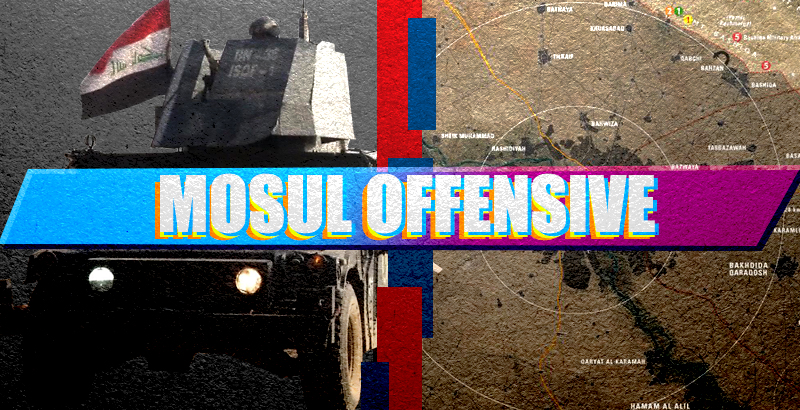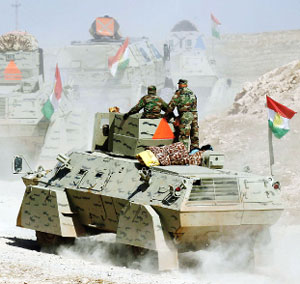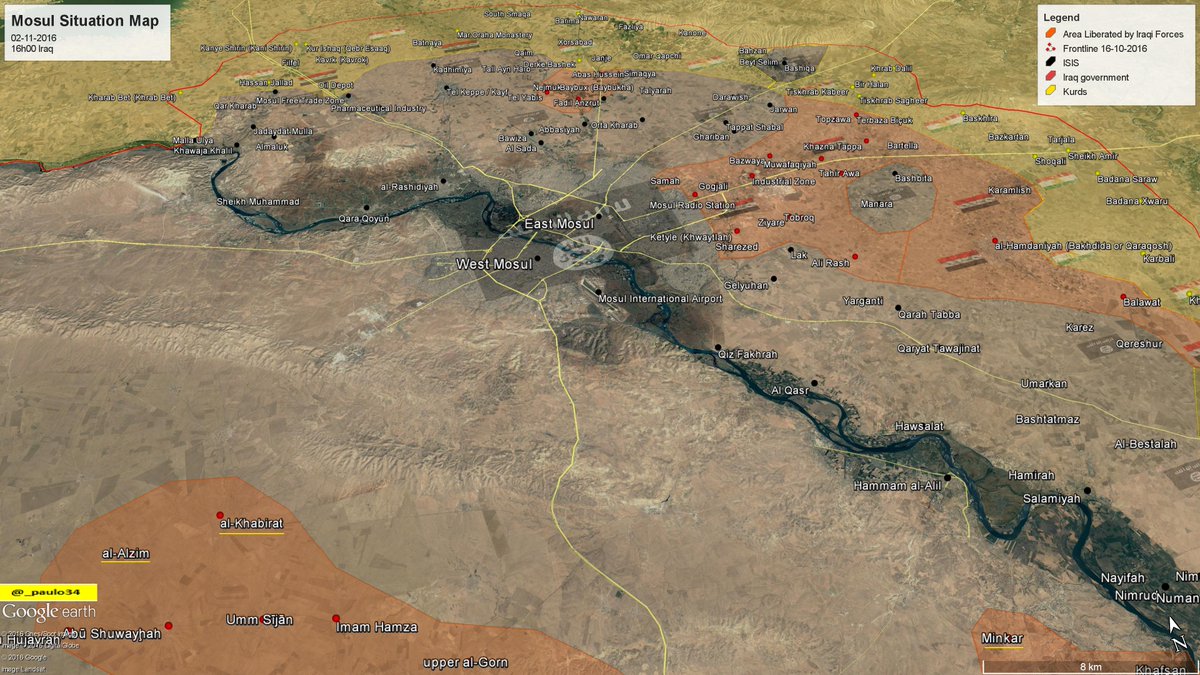When and how will end the much-advertised campaign in Northern Iraq

Written by Pavel Ivanov; Originally appeared at VPK, translated by AlexD exclusively for SouthFront
The Pentagon and the Ministry of Defence of Iraq officially announced that the operation for the liberation of Mosul has begun. The troops are successfully breaking the defences of the banned in Russia Islamist State fighters and advance in the direction of the city. “Victory is near.”
Meanwhile units of terrorists resist, not going on an offensive, but stubbornly defending their positions. The Shahids [Translator’s note: Martyrs in the name of Faith] were unexpectedly effective, actively breaking through against the advancing troops. And so far neither the Iraqi army nor their advisors managed to enter the suburbs. The northern and southern military units stalled, those who have to surround and cut off Mosul from the rest of the territory under IS control.
The events in Iraq instantly created a large wave of commentaries from experts and analysts from various degrees of sanity. A coherent narrative about what truly is happening in Mosul is difficult to find. We will try to sort it out as to how the military actions are proceeding, what are the plans and possibilities of the opponents.
Long in gaining control, slow in executing
First, the American military high command announced plans to storm Mosul at the beginning of the year. The liberation of this city, taken by IS in 2014, had to be the key element in the strategy to defeat the terrorist state. The fall of Mosul, according to Pentagon calculations, would cause the collapse of the fighters’ defences. They would further follow up with several decisive Iraqi military operations, which, as is expected, in the final result will bring the assault on the Syrian city Raqqa, the unofficial capital of the Islamic State.
The operation was given less than six months. According to the original plans the security forces were to complete the defeat of the Islamist fighters in Iraq and to prepare to transfer to Syria.
The lead of such an ambitious operation was given to the 101st Airborne Division of the US Army, who replaced the 82nd Airborne Division in the Ukraine at the beginning of this year. It is worth noting that the American military does not come out as advisors but as planners of the operation and manage the assault.
The upcoming success in Iraq and the fall of IS before the end of this year was announced not only by the representatives of the White House but by Barak Obama himself as well. From the start of the operation of liberating Mosul it turned into some kind of publicity campaign. It is true that the headquarters of the 101st Airborne Division did not share the optimism of the politicians and preferred not to pursue deadlines, but to thoroughly prepare.
Still, at the beginning of this year the Pentagon covertly transferred to Iraq divisions and units of the Marine Corps as well as a few 155-mm howitzers M-777. The Marines operations group, having received the name of Spartan, was deployed not far from Mosul, to the town of Makhmur. Although the howitzers do not reach the town captured by the militants, they allow them to cover with fire all its surrounding areas.
Having just started the planning of the operation, the headquarters of the “Screaming Eagles” (the call name of the 101st Airborne Division) clarified that it will not succeed to concentrate in advance the Iraqi forces for the assault. The fighters were leaving the town on armed pick-ups and were attacking the Iraqi military and police, inflicting heavy losses. In addition, the Islamists were breaking into the rear regions and were raiding warehouses and storage of the Iraqi army. It is clear that in such a situation not a word was permitted about any assault.
For this reason the work of Spartan was formulated extremely simply – to stop the transfer of militants and to drive them towards Mosul. With the help of drones, as well as Iraqi mobile patrols, concentration points of militants’ cars were spotted, their maintenance facilities and movement paths. Next came the artillery. To protect the firing base, where the M-777s were standing, a rifle company of Marines were deployed. And its soldiers were also in contact fights with Islamists, trying to drive them toward Mosul.
At the same time units of the Green Berets came into the game and raiders of the Marine Corps, whose job was to ready divisions and units of the Iraqi army and police, who will assault the town. Only after the two tasks were completed, drive the militants towards Mosul and enclose them there, as well as prepare the Iraqi military, the headquarters of the 101st Airborne Division was to join the assault.
But to fulfill these tasks turned out a bit more complicated. So much so that they were not resolved until October. The militants’ activities decreased but they continued raids on Mosul. The joint efforts of the American commandos and their English, French, Australian and even Dutch allied militaries managed somehow to pull together individual preparedness of the Iraqis. But without advisors they instantly were at a loss, panicked, and the work of the commanders was totally absent.
But Washington started to express its impatience, so with a delay of five-six months the assault on Mosul started.
From the Iraqi side, the most prepared units went to the battle: the 15th and 16th ground troops divisions as well as divisions and units of the 9th Tank Division. Units of police special forces were involved as well as the local militia.
The exact quantity of Western military personnel is not known, but according to prior date, a battalion of Green Berets and about the same commandos of the Marine Corps, in the capacity of advisors to the Iraqi military and police divisions and units, take part in the assault. Close to one hundred Australian Special Forces and around two hundred Canadians help their American colleagues.
A battery of M-777s and a few High Mobility Artillery Rocket System (HIMARS) multiple rocket launchers from the 2nd brigade of the 101st Airborne Division were transferred to the region as well. The French military helped with four self-propelled 155-mm “Cesar” howitzers.
There will be many casualties
The operation plans are quite simple and not because of the weakness of the militants. The level of Iraqi commanders is very low, so to take part in a complex operation, where strong deep manoeuvres are combined, detours and breakthroughs, they are simply not ready. Therefore the assault on Mosul slowly moves from three directions. The troops occupy the towns and villages, after which they are turned over to the police to clean up. The assault is supported by massive artillery fire and air strikes.
 There are four groups operating. One advances from the North on routes No. 1 and No 2. Its mission is to get to the suburbs and establish a blockade. The second group carries out a similar task from the South. The two groups must meet on the Western outskirts of Mosul. This will create an “anvil”.
There are four groups operating. One advances from the North on routes No. 1 and No 2. Its mission is to get to the suburbs and establish a blockade. The second group carries out a similar task from the South. The two groups must meet on the Western outskirts of Mosul. This will create an “anvil”.
The “Hammer” will be two groups, coming from the East, from the direction of the towns of Bartella and Ba’ashiqah. They will surround Mosul. After which, a few divisions of commandos will carry out the assault with the support of tanks and armoured vehicles of the 9th Tank division. It is not excluded that in urban combat “Spartan” Marines will take part, up to now on standby at the operations headquarters.
“Hammer and Anvil” is a classic plan of an anti-partisan operation. There are no “thunderous breakthroughs”, as was during the assault on Baghdad in 2003, nor shots over dozens of kilometres, bypassing key positions of militants and helicopter landing parties. It is a simple slow march under cover of uninterrupted artillery fire.
It is worth to note that up to the start of the assault the militants generally discovered concentration areas of Iraqi military, and discerned the plans of the American command. The IS strategy proceeds from the fact that Washington cannot wait another few months: the USA needs a quick victory. For this reason the headquarters are constantly pushing.
This forces the 101st Airborne Division command to drive the Iraqi divisions towards militant positions not subdued with artillery fire and airstrikes, which leads to not only excessive losses of the assaulting troops but to decreasing morale. It happened at the 2015 assault on Mosul. After suffering losses, the Iraqi troops walked away from the city, and part of the army simply deserted.
So instead of manoeuvre warfare against pickup raids, militants prefer to wage a hard contact defence and strike with suicide bombers, who seriously demoralise the advancing troops.
But this plan has flaws. The Iraqi military, which are led to battle by American Special Forces, are unlikely to run, as was in 2015. The artillery punch, which is controlled by the 101st Airborne Division headquarters, so far presents itself well enough in the eradication of the IS positions.
It is true that the assault on Mosul is still ahead. As experience shows, even the Iraqi elite commandos, led into battle by their American colleagues, quickly run out of steam and start to desert the battle field. That is why the management of the operation is under the Marine combat team “Spartan” and it keeps the ace in the sleeve.
But even under the most successful scenario the liberation of Mosul will unlikely to be achieved in the near future. We have yet to see the bloody spectacle, the assault of the densely populated agglomeration under massive artillery fire with the use of armoured vehicles and aviation. It will not be possible to give the exact time for the end of the meat grinder. It is enough to recall that a whole division of the American Marine Corps with massive support of the entire aviation group was not able to take Iraqi Fallujah in 2004 not even once. After suffering losses, the Marines retreated and repeated all over again. The establishment of full control over the city took almost nine months.




